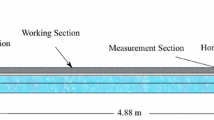Abstract
The results of experimental study of the turbulent flow structure at longitudinal flow around the cellular surface with hexagonal cells of 5-mm size, 21-mm depth and wall thickness of 0.2 mm are presented. The measurements were performed using the PIV system for the developed flow in the channel with cross section of 21×150 mm and length of 1000 mm. Stroboscopic visualization of the flow was performed, and velocity and turbulence components were measured in the channel with and without the cells. It is shown that in a vicinity of cells, the boundary layer is less filled, but it has the higher level of turbulent fluctuations. It is noted that in contrast to the profile on a smooth wall there is no logarithmic region on the cellular surface. In this case, there are no effects of velocity slip on the cellular surface under the experimental conditions.
Similar content being viewed by others
References
S.A. Isaev, N.V. Kornev, A.I. Leontiev, and E. Hassel, Influence of the Reynolds number and the spherical dimple depth on the turbulent heat transfer and hydraulic loss in a narrow channel, Int. J. Heat Mass Transfer, 2010, Vol. 53, P. 178–197.
G.V. Kovalenko, V.I. Terekhov, and A.A. Khalatov, Flow regimes in a single dimple on the channel surface, J. Appl. Mech. Tech. Phys., 2010, Vol. 51, No. 6, P. 839–848.
G.R. Grek, V. Kozlov, and S. Titarenko, An experimental study of the influence of riblets on transition, J. Fluid Mech., 1996, Vol. 315, P. 31–49.
R.K. Shah and A.M. Jacobi, Heat transfer surface enhancement through the use of longitudinal vortices: a review of recent progress, Exp. Thermal and Fluid Sci., 1995, Vol. 11, No. 3, P. 295–309.
R.L. Panton, P. Kevin, K.P. Flynn, and D.G. Bogard, Control of turbulence through a row on Helmholtz resonators, AIAA Paper, 1987, No. 87-0436.
N.N. Kovalnogov and L.V. Khakhaleva, The motion and friction resistance of a turbulent flow in a perforated tube with damping cavities, Izv. VUZ. Aviatsionnaya Tekhnika, 2002, No. 3. P. 19–21.
Y.M. Chung and T. Talha, Effectiveness of active flow control for turbulent skin friction drag reduction, Physics of Fluids, 2011, Vol. 23, No. 2, 025102.
V.I. Kornilov, Reduction of turbulent friction by active and passive methods (Review), Thermophysics and Aeromechanics, 2005, Vol. 12, No. 2, P. 175–196.
A.A. Klimov and S.A. Trdatyan, The use of a honeycomb surface for controlling the boundary layer, High Temperature, 2003, Vol. 41, No. 6, P. 801–806.
S.A. Trdatyan and A.A. Klimov, Friction and heat transfer on a honeycomb surface in laminar and turbulent flows, in: Proc. 12th Int. Heat Transfer Conf., Grenoble, 2002, P. 221.
S.A. Trdatyan and A.A. Klimov, A boundary layer on the honeycomb surface at inleakage of the laminar flow, P.2. Forced convection of the single-phase liquid, in: Proc. 3d Russian National Conference on Heat and Mass Transfer, MEI, Moscow, 2002, P. 281–284.
U. Butt, Experimental investigation of the flow over macroscopic hexagonal structured surfaces, Von der Fakultät für Maschinenbau, Elektrotechnik und Wirtschaftsingenieurwesen der Brandenburgischen Technischen Universität Cottbus-Senftenberg zur Erlangung des akademischen Grades eines Doktor-Ingenieurs genehmigte Dissertation, Brandenburg, April 2014.
N.N. Kovalnogov, The model of turbulent transfer in a boundary layer on the perforated surface with tight damping cavities, Izv. VUZ. Problemy energetiki, 2003, No. 5–6, P. 41–47.
M. Hiwada, T. Kawamura, J. Mabuchi, and M. Kumada, Some characteristics of flow pattern and heat transfer past a circular cylindrical cavity, Bull. JSME, 1983, Vol. 26, No. 220, P. 1744–1752.
V.I. Terekhov, S. V. Kalinina, and Yu.M. Mshvidobadze, Experimental study of flow development in the channel with a semispherical cavity, Sibirsk. fiziko-tekhn. zhurnal, 1992, No. 1, P. 77–85.
V.I. Terekhov, N.I. Yarygina, and A.V. Shaporin, Heat transfer in three-dimensional separated flow in a rectangular cavity, Industrial Heat Transfer, 1999, Vol. 21, No. 2–3, P. 22–25.
S.S. Kutateladze and A.I. Leontiev, Heat Transfer, Mass Transfer and Friction in Turbulent Boundary Layers, Hemisphere Publishing Corporation, 1989.
Author information
Authors and Affiliations
Corresponding author
Additional information
The work was financially supported by the Russian Science Foundation (Grant No. 14-19-00402).
Rights and permissions
About this article
Cite this article
Terekhov, V.I., Smulsky, Y.I., Sharov, K.A. et al. Boundary-layer structure in the flow around the cellular surface in a flat channel. Thermophys. Aeromech. 21, 701–706 (2014). https://doi.org/10.1134/S0869864314060043
Received:
Revised:
Published:
Issue Date:
DOI: https://doi.org/10.1134/S0869864314060043




